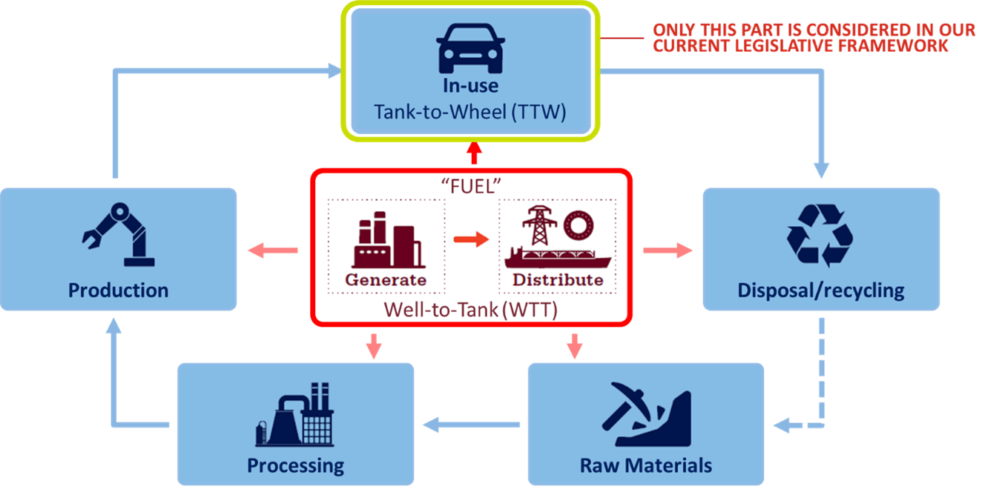It is widely recognised that the decarbonisation of our road transport sector is increasingly urgent and important in the race to address climate change, with about 27% of UK greenhouse gas (GHG) emissions currently coming from this sector. In addition, for the benefit of the population’s health, there is a need to improve air quality in our towns and cities, where road transport emissions are one of the biggest contributors to localized air pollution.
The UK government has already taken steps with the “Road to Zero” strategy and the recent announcement of the “10-point plan for a green industrial revolution”. The latter plans to end the sale of new petrol and diesel cars and vans by 2030, and requires all vehicles to have a significant zero emissions capability (e.g. plug-in and full hybrids) from 2030 and be 100% zero emissions from 2035.

Whilst these vehicles are described as zero emissions, we need to be careful as the actual definition in this case is zero emissions at point of use. These vehicles are far from zero emissions when their whole life-cycle is considered. Like all vehicles, emissions are produced throughout the entire vehicle production process, from raw material extraction through manufacturing, use and disposal/recycling (Figure 1), but the balance between the phases is different for the different propulsion systems. And not forgetting the “fuels” of course, be it oil, natural gas, petrol/Diesel, electricity or hydrogen. The production of these also needs to be considered.
The IMechE’s recent report, “Accelerating Road Transport Decarbonisation”, strongly recommended the adoption of life-cycle analysis to support policy decisions and avoid unforeseen consequences and it is this report that provides some of the sources for this article.
We don’t have time to argue about which technology is best and we cannot afford the luxury of banning technologies some don’t like
As engineers we are acutely aware of the impact of our system boundary. For the climate, the system boundary is very simple – it is the planet. Arbitrarily focusing our efforts on reducing one part of this life-cycle to zero runs the risk of simply shifting the emissions burden elsewhere in the life-cycle, into different sectors (e.g. industry) or even geographies. Drawing the boundary around one part of the life-cycle of one product, or drawing a boundary around a city, state or country might make it seem like we are making progress but, ultimately, the emissions are still produced and enter the atmosphere somewhere, often in poorer and marginalized communities.
From this holistic viewpoint, the GHG emissions of conventionally powered vehicles are dominated by the in-use phase, with a relatively low footprint from vehicle manufacture and disposal/re-cycling. Conversely, the carbon footprint of electric vehicles tends to be dominated by the manufacturing phase as the GHG emissions associated with the cell and pack manufacture significantly outweighs that produced in use. Polestar, an electric vehicle manufacturer, recently published their LCA analysis for the Polestar 2 vehicle compared to a Volvo XC40 that estimated the crossover point to be anywhere between 50,000 and 112,000km, usually depending on the carbon intensity (gCO2e/kWh) of electricity grid used for charging. Whilst other researchers will no doubt find fault with their analysis, Polestar should be applauded for attempting to be transparent regarding GHG emissions.

The push to more electrification is absolutely the correct trajectory for light duty vehicles, but we must be aware of the associated challenges and issues such as affordability, range anxiety and charging infrastructure. But, perhaps more importantly, banning alternative technologies closes off other potential complementary solutions that could also have a big impact on GHG emissions. Technologies such as sustainable fuels.
Apart from a few specific examples, sustainable fuels are generally hydrocarbon fuels much like we use today but the carbon comes from recycled biological, industrial or atmospheric sources rather than fossil sources buried in the ground. There are a number of routes to manufacture of sustainable fuels that we don’t have time to go into here, but they range from advanced biofuels (made from waste), through synthetic fuels up to e-fuels that use green hydrogen to make the most advanced synthetic hydrocarbons.
One of the main opportunities for these fuels is that they can be manufactured to be direct replacements for the conventional fossil fuels we use today (so called “drop-in” fuels). This has the potential to be enormously powerful in our battle against climate change as:
- They enable us to start addressing the existing fleet. There are currently >34 million passenger cars and light vans on the road in the UK using conventional engines, and more will be added between now and 2035, even in hybrid form. We can start with a relatively modest blend of sustainable content with conventional fuel, ramping up over time. We cannot afford to wait until 2030 or 2035 and hope that electrification fixes everything. It’s all about the area under the curve – the sooner we start, the more impact we will have.
- In combination with plug-in hybrids, they enable a much more managed transition to full electric vehicles both in terms of the consumer experience and the associated infrastructure requirements.
- They minimise the embedded CO2 in the manufacture of battery packs as the batteries can be sized for the majority of journeys rather than the occasional long journey. Instead, the vehicle would rely on the internal combustion engine to complete that long journey.
More on low carbon transport
Developing sustainable combustion engines
APC's Julian Hetherington on automotive propulsion innovations
So why aren’t we doing this? The primary problems are availability and cost. These fuels are more expensive than their fossil counterparts and there is currently no business case to support any investment to improve process efficiencies, scale up and drive costs down as no one sees a commercial benefit. Unlike charging an electric vehicle, consumers are not “rewarded” for using a renewable fuel in that you still pay a substantial fuel duty. The car manufacturers are not rewarded for making a vehicle that can use a sustainable fuel and they have no control over what fuel we put in our vehicles anyway. Whilst there are pilot plants in development (such as the Repsol/Aramco plant in Bilbao, the HIF project in Chile and Nordic Blue in Norway), the major fuel producers are not incentivised for making renewable fuels in a way that encourages them to scale up. And the current tone from government does nothing to stimulate investment in anything that is remotely associated with the internal combustion engine.
In summary, we don’t have time to argue about which technology is best and we cannot afford the luxury of banning technologies some don’t like. Instead, we need all the levers available to us start making a difference right now. Investment in sustainable fuel technology would be a welcome complementary solution to electrification and would pave the way for the necessary industrial growth to support other, much harder sectors to electrify, such as aviation and marine where energy density requirements dictate that sustainable fuels will be a major part of their decarbonisation plans.
Steve Sapsford is the Chair of the Institution of Mechanical Engineer’s Powertrain Systems and Fuels Group










Water Sector Talent Exodus Could Cripple The Sector
Maybe if things are essential for the running of a country and we want to pay a fair price we should be running these utilities on a not for profit...